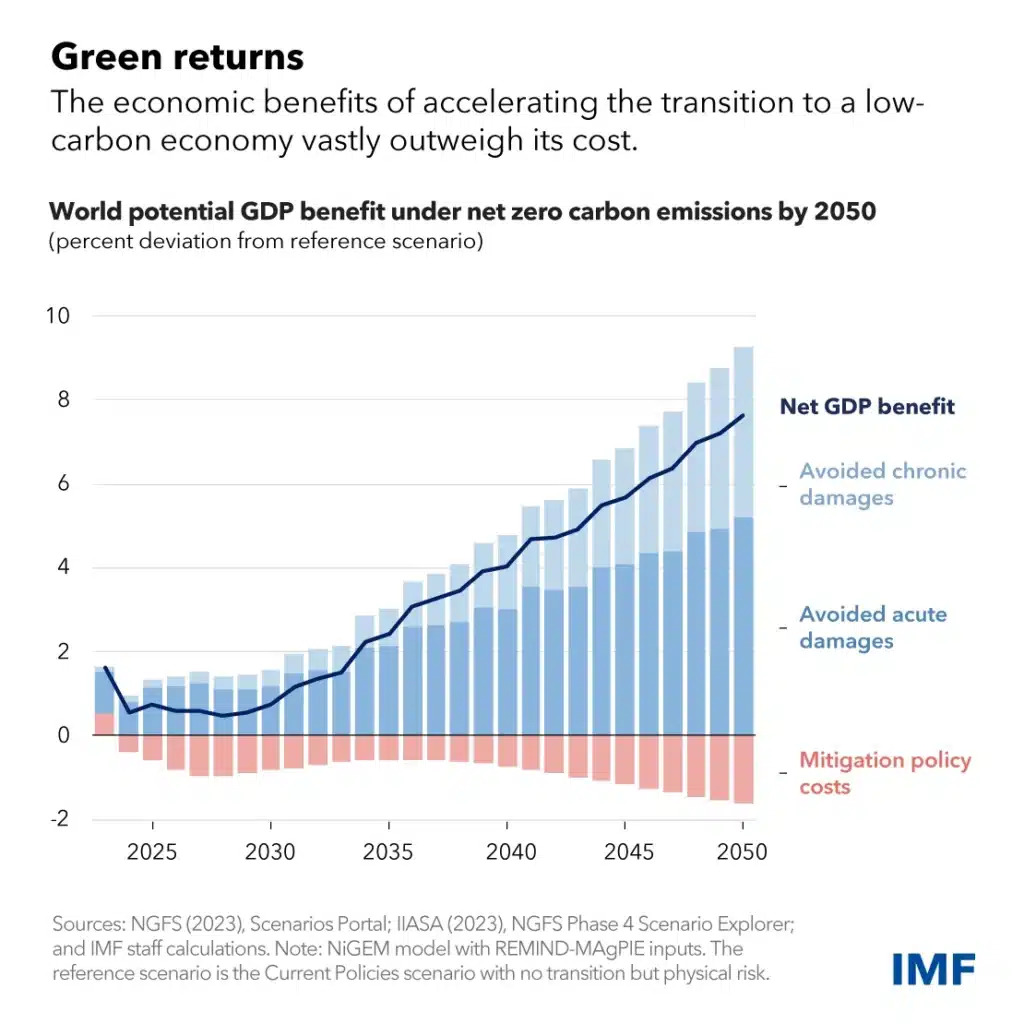The IMF says spending trillions on climate mitigation could improve global GDP. Sure it might.
A recent social media post by the International Monetary Fund reads thus: ‘The economic case for climate action is crystal clear. The latest data from the IMF’s Climate Change Indicators Dashboard reveals that making an orderly transition to net zero by 2050 could result in global GDP being 7% higher than under current policies.’
It illustrates the point with this chart:

Where to even begin?
GDP is a very poor measure of economic well-being, for starters. It measures any and all economic activity, whether it is productive private-sector activity, or wasteful government spending on half-completed, sub-standard, under-performing projects.
A wartime economy, in which creation happens for the sake of destruction, can look just as good, GDP-wise, as a peacetime economy, in which creation happens for its own sake. Clearly, one of these is preferable, and the other deplorable. One of these makes us more prosperous. The other makes us poorer. But GDP data won’t tell you which is which.
Artificial
The IMF chart, however, is premised on an entirely different principle. It does not look at GDP in its entirety, but only at two contributors to GDP: the estimated expense of measures designed to mitigate climate change, which it guesses will amount to nearly 2% of global GDP in 2050 if the world is to achieve ‘net zero’ carbon emissions, and the benefit of damages that this mitigation strategy is expected to avoid.
A neat chart like this, complete with uneven change from year to year, gives the impression that the authors went out and actually measured something. They didn’t, of course. The unevenness is entirely artificial, introduced just to make it look more realistic.
So, what is it that they’re projecting?
Scenarios
If you dig into their source for this data, an association of central banks and financial supervisors who call themselves the Network for Greening the Financial System (NGFS), you’ll note that they compare two scenarios.
The first is a world in which climate policies do not change at all, which they dub the ‘hothouse world scenario’. The second is a net zero by 2050 world, which they call ‘orderly scenario’.
Right off the bat, one can make the objection that neither of these scenarios is even remotely likely, so any conclusions drawn from these scenarios deliberately exaggerate the net benefit they want to demonstrate.
It is inconceivable that the world suddenly stops doing anything about climate change. So, the benchmark, or the baseline, is set unreasonably low.
The International Energy Agency says ‘the pledges by governments to date – even if fully achieved – fall well short of what is required to bring global energy-related carbon dioxide emissions to net zero by 2050’.
It is therefore highly unlikely that the entire world will achieve net zero by 2050. Therefore, the claimed benefit is set unreasonably high.
Economic costs
The cost of mitigating climate change between now and 2050 will add up to north of $50 trillion, if the IMF’s chart is to be believed, but it excludes some of the most important economic impacts.
One such cost is the impact of higher energy prices. All countries that have moved heavily towards ‘green’ energy have also seen dramatic increases in electricity tariffs. This has an impact throughout the economy and will be reflected in the cost of all goods and most services. These higher costs will make us poorer.
More than 90% of heavy industry will be expected to operate using low-emission technologies, which will also mean higher costs to power furnaces and heavy machinery. (If the costs were lower, they’d be using low-emission processes already.) Again, this will reflect in prices, which will make us poorer.
There’s also the additional expense of constructing buildings that are ‘zero-carbon-ready’, which 85% of all buildings will have to be by 2050. Who turns over 85% of their building stock in a mere 25 years? If we all have to pay more for our houses, offices and factories, because they come with fancy zero-emission technology, then we’re all going to be poorer.
These are not minor costs. They compound throughout the economy and could easily be worth several percentage points of GDP.
So, there is reason to question the projection that the costs of reaching net zero by 2050 will never exceed 2% of a given year’s global GDP (although even that is high).
‘Potential’ benefits
On the other side of the scale are the anticipated potential benefits from avoiding physical damages from the impacts of climate change.
These numbers are entirely hypothetical. The authors could make these as low or high as they pleased, without fear of contradiction, because there simply is no verifiable data upon which to base such a projection. It’s all based on assumptions.
The word ‘potential’ is made to do some very heavy lifting here.
According to the latest assessment by the Inter-Governmental Panel on Climate Change (IPCC), there are very few climate impact-drivers (that is, climate phenomena that have positive or negative effects on humanity or ecosystems) that are already visible in the historical record.

These extend to a high confidence of an increase in mean air temperature, mean ocean temperature, and heatwaves; a high confidence in a decrease in lake, river, and sea ice; a medium confidence in an increase in ocean salinity; and a medium confidence in a decrease in cold spells, permafrost, and dissolved oxygen in the ocean.
For all the other stuff you hear about, like floods, rain, droughts, fire, storms, and sea level – that is, the stuff that could actually cause damage – the IPCC has ‘low confidence in the direction of change’. That is, there’s nothing in the data.
Exceptionally unlikely
That changes by 2050, at least for the worst-case scenario known as ‘RCP8.5/SSP5-8.5’. The eminent journal Nature warned us, and the IPCC, that this scenario shouldn’t be used for informing policy because it was intended as a worst-case scenario in which no mitigating action at all was taken but the use of coal was dramatically expanded. This scenario is now considered exceptionally unlikely.
If, however, we did dramatically expand the use of coal around the world, and did nothing at all to limit carbon emissions, then, the IPCC tells us, they would have a high confidence that mean precipitation would either increase or decrease, depending on where you are; a high confidence that ocean acidity would increase; and a medium confidence that snow, glaciers and ice sheets would decrease and that relative sea level would increase.
That’s it. Even in the worst-case scenario, the IPCC foresees no trends in floods, landslides, aridity or drought, fire, windstorms and cyclones, or any of the other possible sources of actual damage, by 2050.
Understatement
It is a mystery, then, where the central bankers at NGFS find all this damage that a net zero strategy would avoid, in order to forecast a net benefit of 7% to global GDP by 2050.
Even if climate change really does cause such extensive damages, there is no evidence to suggest that mitigation efforts will materially reduce or avoid these damages.
This assessment underestimates the likely costs and negative economic impacts of climate mitigation, and wildly overestimates the likely damage that climate mitigation might prevent.
To call this speculation is an understatement. It’s more like speculative fiction.
The views of the writer are not necessarily the views of the Daily Friend or the IRR
If you like what you have just read, support the Daily Friend

